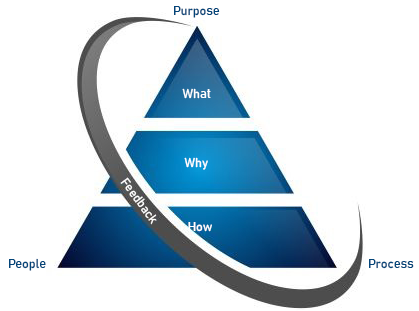“Success is never final, failure is never fatal. It’s courage that counts.” – John Wooden
by Jim Solomon and Bruce LaRue, Ph.D.
What was true last year, may have a completely new meaning today. Your strategy, your goals, your customers, and even your workforce, once known and understood, now are likely different.
Today’s leaders must possess the unique ability to see what isn’t there, channeling the collective energy of others to make their vision a reality. This means they need courage to embrace change rather than engaging in futile attempts to manage, adapt to, or resist it.
Those who follow these practices are known as Integrator Leaders, a term we coined to capture the essence of the leader who can thrive in a complex world.
Thrive as an Integrator Leader
Leaders must see the world more as an integrated whole rather than a collection of independent parts. Seeing patterns of connections between thoughts and ideas will help to understand things in terms of systems of complex interdependencies. Much like the challenges and crises we face today, they cannot be seen in isolation nor solved independently of one another. We need Integrator Leaders who can build coalitions of people to create change for today and for future challenges yet known.
The role of the Integrator Leader is to guide, mentor, provide essential resources, and remove barriers to progress, ensuring that the team operates within appropriate boundaries to achieve essential outcomes. They must drive innovation and integrate the efforts of specialized cross-functional teams across the enterprise, while guiding their organizations with a clear purpose.
To thrive in our increasingly volatile and uncertain world, leaders must learn to leverage change to their benefit by building organizations that are more adaptive, agile, creative, and innovative. How we respond to change is ultimately a choice. We can see change as a threat to be avoided or a challenge to be overcome. We can choose to be a victim of our circumstance, or we can learn to leverage change to our advantage. The key is to never surrender our ability to choose how we respond to our situation.

Change Integrator Model©
Thrive by Guiding Your Vision from Concept to Reality
Integrator Leaders set the compass heading and priorities while helping their team self-organize to create an ownership mentality in HOW they accomplish the mission. Throughout this process, be careful to separate WHAT from HOW. That is, keep strategic intent separate from HOW this strategy is operationalized in practice. Today and moving forward, leaders must create nimble, flexible organizations that can adapt and leverage change to their advantage.
The Change Integrator© (shown above) is a tool we created to guide a leader’s vision from concept to reality. It has proven to be just as useful to those leading small teams as to leaders directing global projects. The Change Integrator© reminds the leader to first clarify PURPOSE (strategic intent) with a compelling rationale for WHY, and then ask the team for input as to HOW to get there.
The sequence is always the same: First WHAT, then WHY, finally ask HOW – with a continuous loop of FEEDBACK. That is, after providing the PURPOSE, ask the team for their input, their insights, what is working, and what is not; then help integrate what they have proposed into a course of action. For leaders to have the best operational awareness, they need continuous feedback. This should come from all levels, internal and external to your organization, to allow the leader to “see” things from others perspective.
Purpose: Defining Your Strategic Direction
The Integrator Leader determines the PURPOSE (WHAT & WHY), that is, they must define WHAT is to be accomplished and WHY, in a clear, concise, and compelling manner. This serves as the compass heading or strategic direction. PURPOSE should include strategic priorities, outcome-based success criteria, and expectations of performance linked to priorities.
Defining PURPOSE for your team should begin by letting them see the “world” (your organization, enterprise, etc) from the canopy view. The idea is to widen everyone’s aperture so that they see their actions within the broader organizational context. The canopy view enables workers at all levels to become more productive and efficient, and better able to align their efforts with those of the broader organization. Do not make the mistake of assuming everyone understands the common purpose. Providing your team with a view from the canopy gives them a clear line of sight to their goal. Show them where they are going and then ask them how to get there.
Two good examples from organizations that provide a clear PURPOSE for their team are Southwest Airlines, a highly successful corporation with thousands of employees and Commando Military Supply, a small family-owned, single store, retail business with less than 65 employees. Interesting to note, both organizations were severely impacted by the 2020-2021 global COVID pandemic, yet their employees remained committed, their customers remained loyal to the extent possible, and now both are emerging from the pandemic and will continue to thrive.
Southwest Airlines – Purpose: “Connect People to what’s important in their lives through friendly, reliable, and low-cost air travel.”
Commando Military Supply – Purpose: “The Soldiers’ One Stop Shop.”
Why: The Rationale for Change
To get your team fully engaged and to want to be a part of any changes or new priorities that are to be proposed, they must be provided a rationale to spark their passion. Helping the team to see through the lens of the customer, the organization, and the team, can inspire even those a bit skeptical.
Why Will This Change Benefit Our Customer? Looking back at the Change Integrator©, the top of the triangle represents PURPOSE, and this must always be focused on outcomes to be achieved for the customer. Any change proposed must clearly benefit the customer.
Why Will This Change Benefit Our Organization? With a focus on innovation and channeling the collective energy of their team to make their vision a reality, leaders must also consider the impact that this may have on the quality of life for their employees.
Why Will This Change Benefit Individuals? Today’s workers tend to be more committed to the development of their own portfolio of skills than they are to any organization. They want to be part of the changes that affect them. They want equal measures of autonomy and teamwork where they can sharpen one another’s skills, share best practices, and collaborate on projects.
What’s in It for Me? We are all human, and as passionate as your team may be about the work, it’s natural to consider personal impact. Help to connect the dots for the team, showing them a direct link between the success of the organization and their own success.
Bill Hogg, an internationally recognized leadership consultant, shares that employees must have passion for their work to achieve the greatest success. In his recent blog “5 Ways To Ignite Passion In Your Team” he suggests that it is the leader’s responsibility to create this passion in their team. When these practices are coupled with the leader’s compelling rationale for WHY, teams are then positioned to take the next step – creating the HOW.
How: Crafting the Roadmap
With your compass heading defined, it is time to ask your team to create the roadmap to get you there. To the extent they will be affected by it, we want to include them in HOW to design and implement the change.
Ask, don’t tell; coach, mentor, and guide them, but don’t tell them HOW. Never allow process to be a substitute for thinking. Tell your team that you don’t want them to simply follow processes; but instead, you expect them to analyze and perfect them. The leader’s role is to guide the team to their own solution. The more they own the solution, the less you will have to manage them, and the happier your customers will be.
SpaceX and Tesla Motors Founder Elon Musk feels all on his team must be creative and innovative thinkers. Musk goes so far as to say, “I don’t believe in process. In fact, when I interview a potential employee and he or she says that ‘it’s all about the process,’ I see that as a bad sign.” Clearly, Musk is not advocating a complete absence of process. Instead, we do not want our standard operating procedures to become substitutes for thinking and straitjackets that limit our ability to think and act creatively.
The Feedback Loop
The feedback loop on the Change Integrator© represents a constant real-time integration of strategy and action that goes both ways. It symbolizes the critical need to ensure that strategy is being informed by action, the action is being informed by strategy, and that WHAT and HOW are always aligned. It symbolizes our ability to identify and exploit unforeseen opportunities and to spawn new innovations. The feedback loop also reminds us that tactical decisions have strategic consequences.
We have frequently seen knowledge and expertise hidden away inside people’s heads, housed in fragmented databases, or within pockets of the organization, where it is not widely shared and therefore cannot make the rest of the system smarter. Too often, critical knowledge exists within silos and stovepipes, meaning that many organizations literally do not know what they know.
As an Integrator Leader, you can’t over-communicate; and communication requires learning to listen as well. Listen closely to your own people and utilize the critical operational intelligence that exists throughout the organization. Let your team know that you are not only open to their input, but that you expect it.
Thrive During Times of Great Change
It takes courageous leaders to move forward during turbulent times. While others wait out the storm, Integrator Leaders continue to see possibilities where others see obstacles. They inspire their team with fresh visions of the future. They empower, guide, and coach their team to own the actions required to move from where they are to where they need to be. Those who engage in the practices of the Integrator Leader establish the path for both themselves and their organizations to thrive today and tomorrow.
Integrator Leader Reflections
- Are you setting the compass heading for your team with clear intent and compelling rationale to guide their action?
- Are you focusing on WHAT and WHY while empowering your team to come up with HOW to get you there?
- What personal course corrections can you make to best align your leadership practices to those of the Integrator Leader?
Note: To learn more about Integrator Leader© practices or the Change Integrator©, read Seeing What Isn’t There – A Leader’s Guide to Creating Change in a Complex World.
www.chambersbayinstitute.com ● leadership@chambersbayinstitute.com


You must be logged in to post a comment.